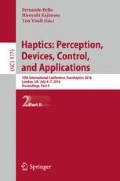Abstract
Bodily movements caused involuntarily, for example while using a Ouija board, are called ideomotor actions. Our goal is to clarify the conditions under which Ouija board motion occurs, comparing visual, force, and vibrotactile cues and using a novel pseudo haptic illusion. In this study, we used a fingertip-type tactile display to find the conditions of occurrence of ideomotor action with the Ouija board. Results showed that vibrotactile cues lead to the occurrence of Ouija board motion, and that visual cues reinforce the displacement of motion.
Access this chapter
Tax calculation will be finalised at checkout
Purchases are for personal use only
References
Stock, A., Stock, C.: A short history of ideo-motor action. Psychol. Res. 68(2–3), 176–188 (2004)
Amemiya, T., Gomi, H.: Distinct pseudo-attraction force sensation by a thumb-sized vibrator that oscillates asymmetrically. In: Auvray, M., Duriez, C. (eds.) EuroHaptics 2014, Part II. LNCS, vol. 8619, pp. 88–95. Springer, Heidelberg (2014)
Rekimoto, J.: Traxion: a tactile interaction device with virtual force sensation. In: Proceedings of the ACM Symposium of User Interface Software and Technology, pp. 427–432 (2013)
Yem, V., Kuzuoka, H., Yamashita, N., Ohta, S., Takeuchi, Y.: Hand-Skill learning using outer-covering haptic display. In: Auvray, M., Duriez, C. (eds.) EuroHaptics 2014, Part I. LNCS, vol. 8618, pp. 201–207. Springer, Heidelberg (2014)
Kuniyasu, Y., Sato, M., Fukushima, S., Kajimoto, H.: Transmission of forearm motion by tangential deformation of the skin. In: Proceedings of Augmented Human International Conference (2012)
Shull, P., Bark, K., Cutosky, M.: Skin nonlinearities and their effect on user perception for rotational skin stretch. In: Proceedings of the IEEE Haptics Symposium, pp. 77–82 (2010)
Kojima, Y., Hashimoto, Y., Kajimoto, H.: Pull-Navi. In: Proceedings of the ACM SIGGRAPH Emerging Technologies Session (2009)
Sato, M., Matsue, R., Hashimoto, Y., Kajimoto, H.: Development of a head rotation interface by using hanger reflex. In: Proceedings of the IEEE International Symposium on Robot and Human Interactive Communication, pp. 534–538 (2009)
Nakamura, T., Nishimura, N., Sato, M., Kajimoto, H.: Development of a wrist-twisting haptic display using the hanger reflex. In: Proceedings of Advances in Computer Entertainment Technology Conference (2014)
Shikata, K., Makino, Y., and Shinoda, H.: Inducing elbow joint flexion by shear deformation of arm skin. In: Proceedings of World Haptics Conference (2015)
Sato, M., Nakamura, T., Kajimoto, H.: Movement and pseudo haptics induced by skin lateral deformation in hanger reflex. In: Proceedings of Special Interest Group on Telexistence (in Japanese) (2014)
Edin, B.B., Johansson, N.: Skin strain patterns provide kinaesthetic information to the human central nervous system. J. Physiol. 487(1), 243–251 (1995)
Collins, D.F., Prochazka, A.: Movement illusions evoked by ensemble cutaneous input from the dorsum of the human hand. J. Physiol. 496(3), 857–871 (1996)
Ebied, A.M., Kemp, G.J., Frostick, S.P.: The role of cutaneous sensation in the motor function of the hand. J. Orthop. Res. 22(4), 862–866 (2004)
Mengchen, Z. Farheen, T.: OuijaPlus: A force feedback Ouija board. In: Proceedings of Human Interface Technologies (2008)
Saga, S., Deguchi, K.: Lateral-force-based 2.5-dimensional tactile display for touch screen. In: Proceedings of Haptics Symposium, pp. 15–22 (2012)
Sato, M., Isshiki, M., Liping, L., Akahane, K.: Spidar-mouse: a design of open source interface for SPIDAR. In: Proceedings of Human Communication Group Symposium (in Japanese) (2009)
Acknowledgment
This work was supported by JSPS KAKENHI Grant Number 15H05923 (Grant-in-Aid for Scientific Research on Innovative Areas, “Innovative SHITSUKSAN Science and Technology”).
Author information
Authors and Affiliations
Corresponding author
Editor information
Editors and Affiliations
Rights and permissions
Copyright information
© 2016 Springer International Publishing Switzerland
About this paper
Cite this paper
Shitara, T., Nakai, Y., Uematsu, H., Vibol, Y., Kajimoto, H., Saga, S. (2016). Reconsideration of Ouija Board Motion in Terms of Haptics Illusions. In: Bello, F., Kajimoto, H., Visell, Y. (eds) Haptics: Perception, Devices, Control, and Applications. EuroHaptics 2016. Lecture Notes in Computer Science(), vol 9775. Springer, Cham. https://doi.org/10.1007/978-3-319-42324-1_14
Download citation
DOI: https://doi.org/10.1007/978-3-319-42324-1_14
Published:
Publisher Name: Springer, Cham
Print ISBN: 978-3-319-42323-4
Online ISBN: 978-3-319-42324-1
eBook Packages: Computer ScienceComputer Science (R0)

